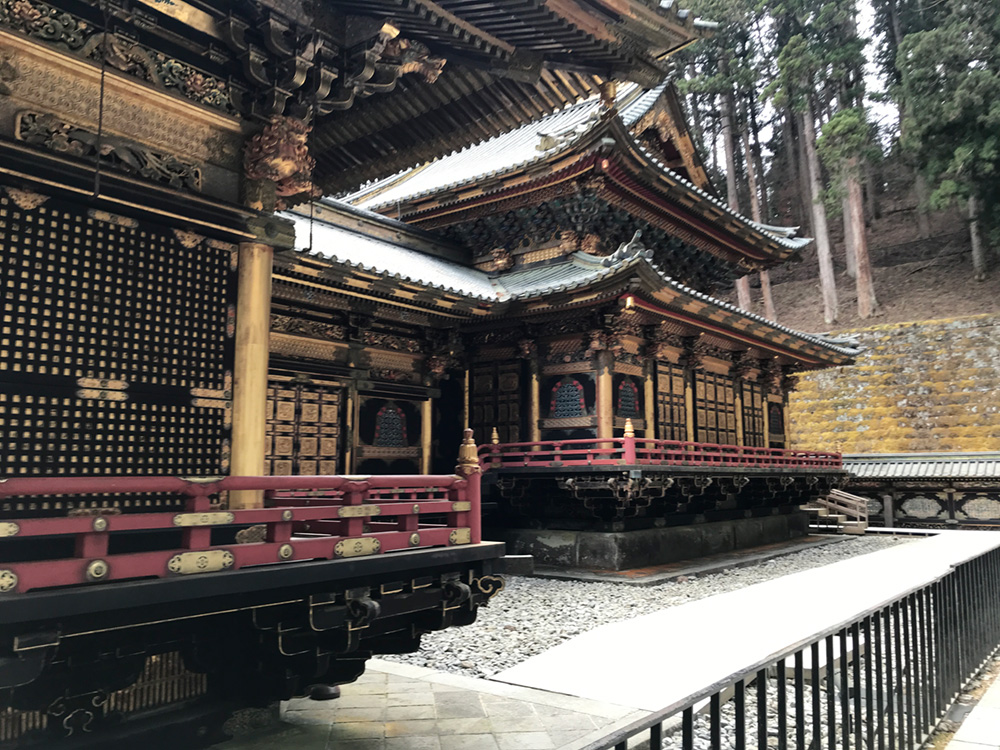本殿・相の間・拝殿
Honden, Main Hall, and Haiden, Prayer Hall
正殿和拜殿
正殿和拜殿
혼덴(본전), 하이덴(기도실)
Honden, hall principal et Haiden, hall de prière
Honden, Haupthalle und Haiden, Gebetshalle
Honden, el Pabellón Principal y Haiden, el Pabellón de Oración
ฮนเด็น (Honden) ห้องโถงใหญ่ และไฮเด็น (Haiden) หอสวดมนต์

大猷院の中心となる建物で、国宝に指定されています。ここでは月に一度、法要が行われます。特に家光公の御命日にあたる4月20日の法要は大きなものです。
手前から拝殿・相の間・本殿と、3つの部屋の並ぶ造りを「権現造り」と言います。たくさんの金箔が使われていることから、別名を「金閣殿」と呼ばれています。
The Main Hall of the Taiyuin Mausoleum is an ornate structure covered in intricate carvings, designs, and so much gold leaf that it is also known as “The Golden Pavilion,” or Kinkakuden. It is here that the spirit of Iemitsu is enshrined. The building is constructed in three distinct sections: the outer Prayer Hall, the inner Main Hall, and the passageway connecting the two. This is a style of architecture known as gongen zukuri. Typically shrines and temples face towards the auspicious southern direction, but this building faces northeast towards Toshogu to honor Iemitsu’s grandfather, who is buried there. The statue of the Buddhist deity venerated in the Main Hall nevertheless faces south.
Directly in front of the Main Hall is a collection of bronze lanterns donated by the most powerful feudal lords in the country with the exception of one pair, which is a gift from the king of Korea. The six lanterns located closest to the hall were donated by the three cadet branches of the Tokugawa house. Each family donated a pair of lanterns.
大猷院的正殿是一座华美的建筑,上面覆盖着精致繁复的雕刻、图案和大量金箔,因此也被称为“金阁殿”。正是这里供奉着德川家光的亡灵。这座建筑分为三个不同的区域:外部的拜殿、内部的正殿以及连接两者的走廊。这是一种称为“权现造”的建筑风格。通常,神社和寺庙面朝寓意吉祥的南方,但这座建筑面向东北方的东照宫,以表德川家光对埋葬在那里的祖父的尊敬。但供奉在正殿中的佛像仍然朝南。
正殿正前方是日本最显赫的封建大名捐奉的一众青铜灯笼,但其中一对是朝鲜国王的礼物。最靠近大殿的六座灯笼是德川御三家捐奉的。每个家族都捐奉了一对灯笼。
大猷院的正殿是一座華美的建築,上面覆蓋著精緻繁複的雕刻、圖案和大量金箔,因此也被稱為“金閣殿”。正是這裡供奉著德川家光的亡靈。這座建築分為三個不同的區域:外部的拜殿、內部的正殿以及連接兩者的走廊。這是一種稱為“權現造”的建築風格。通常,神社和寺廟面朝寓意吉祥的南方,但這座建築面向東北方的東照宮,以表德川家光對埋葬在那裡的祖父的尊敬。但供奉在正殿中的佛像仍然朝南。
正殿正前方是日本最顯赫的封建大名捐奉的一眾青銅燈籠,但其中一對是朝鮮國王的禮物。最靠近大殿的六座燈籠是德川御三家捐奉的。每個家族都捐奉了一對燈籠。
다이유인 묘의 본전은 복잡한 조각과 디자인이 화려한 건축물입니다. 많은 부분이 금박으로 덮여 있어 금각전(긴카쿠덴)이라고도 합니다. 이에미츠의 영혼이 모셔진 곳입니다. 건물은 외부 기도실, 내부 본전 그리고 두 구역을 연결하는 통로의 세 부분으로 구성되어 있습니다. 이것은 곤겐즈쿠리라 부르는 건축 양식입니다. 일반적으로 신사와 사찰은 상서로운 남쪽 방향을 향하지만 이곳은 북쪽인 도쇼구를 향하고 있습니다. 그곳에 묻힌 이에미츠의 할아버지를 기리는 의미입니다. 하지만 본전에 있는 불상은 남쪽을 향하고 있습니다.
본전 바로 앞에 있는 청동 등은 조선 왕이 선물한 한 쌍을 제외하고는 모두 전국에서 가장 세력이 강한 다이묘들이 기증한 것입니다. 본전에서 가장 가까운 6개의 등은 도쿠가와 가문의 어삼경에서 기증한 것입니다. 세 무사 가문에서 한 쌍씩 기증했습니다.
Le hall principal du mausolée du Taiyû-in est une structure décorée, recouverte de sculptures complexes, de dessins et d’un nombre si important de feuilles d'or qu'elle est également connue sous le nom de « pavillon d'or » ou Kinkakuden. C'est ici que l'esprit d'Iemitsu est consacré. Le bâtiment est construit en trois sections distinctes : le hall de prière extérieur, le hall principal intérieur et le passage reliant les deux. C'est un style d'architecture connu sous le nom de gongen zukuri. Généralement, les sanctuaires et les temples font face à la direction favorable du sud, mais ce bâtiment fait face au nord-est, en direction de Tōshō-gū, pour honorer le grand-père d'Iemitsu, qui y est enterré. La statue de la divinité bouddhiste vénérée dans le hall principal fait néanmoins face au sud.
Juste en face du hall principal se trouve une collection de lanternes en bronze données par les seigneurs féodaux les plus puissants du pays, à l'exception d'une paire qui est un cadeau du roi de Corée. Les six lanternes situées le plus près du hall furent données par les trois branches des cadets de la maison Tokugawa. Chaque famille a fait don d'une paire de lanternes.
Die Haupthalle des Taiyuin-Mausoleums weist eine kunstvolle Struktur auf, die mit aufwändigen Schnitzereien, Mustern und so viel Blattgold versehen ist, dass sie auch als „Goldener Pavillon“ oder Kinkakuden bekannt ist. Hier wurde die Seele Iemitsus eingeschreint. Das Gebäude besteht aus drei verschiedenen Abschnitten: der äußeren Gebetshalle, der inneren Haupthalle und dem Durchgang, der die beiden verbindet. Dies ist ein Architekturstil, der als Gongen-zukuri bekannt ist. Typischerweise sind Schreine und Tempel nach Süden gerichtet, aber das Gebäude ist nach Nordosten in Richtung des Toshogu gerichtet, um Iemitsus Großvater zu ehren, der dort begraben ist. Die in der Haupthalle aufgestellte Statue der buddhistischen Gottheit ist dennoch nach Süden ausgerichtet.
Direkt vor der Haupthalle befindet sich eine Sammlung von Bronzelaternen, die von den mächtigsten Fürsten des Landes gespendet wurden, mit Ausnahme eines Paares, das ein Geschenk des Königs von Korea ist. Die sechs Laternen, die am nächsten zur Halle stehen, wurden von den drei Kadettengruppen des Tokugawa-Hauses gespendet. Jede Familie spendete ein Paar Laternen.
El Pabellón Principal del mausoleo Taiyuin es una estructura ornamentada cubierta de intrincados tallados, diseños y tanto pan de oro que también se lo conoce como el “Pabellón Dorado”, o Kinkakuden. Es aquí donde se consagra el espíritu de Iemitsu. El edificio está construido en tres secciones distintas: el Pabellón de Oración exterior, el Pabellón Principal interior y el pasaje que los conecta. Su estilo arquitectónico se conoce como gongen zukuri. Normalmente los santuarios y templos están orientados de cara a la auspiciosa dirección sur, pero este edificio mira al noreste, hacia el Toshogu, en honor al abuelo de Iemitsu, que está enterrado allí. La estatua de la deidad budista venerada en el Pabellón Principal, sin embargo, está orientada al sur.
Directamente frente al Pabellón Principal hay una colección de linternas de bronce donadas por los señores feudales más poderosos del país, con la excepción de un par, que son un regalo del rey de Corea. Las seis linternas más cercanas al pabellón fueron donadas por las tres ramas cadetes de la casa Tokugawa. Cada familia donó un par de linternas.
ห้องโถงใหญ่ของสุสานไทยูอิน (Taiyuin) เป็นสิ่งก่อสร้างที่หรูหราซึ่งเต็มไปด้วยงานแกะสลัก ลวดลาย และหุ้มด้วยทองคำเปลวที่สลับซับซ้อน จนเป็นที่รู้จักกันในชื่อ "ศาลาทองคำ" หรือ คินกากุเด็น (Kinkakuden) โดยเป็นที่ประดิษฐานดวงวิญญาณของอิเอมิตสึ (Iemitsu) อาคารแห่งนี้ถูกสร้างขึ้นโดยแบ่งเป็นสามส่วนที่แตกต่างกันไป คือ หอสวดมนต์ด้านนอก ห้องโถงใหญ่ด้านใน และทางเดินเชื่อมระหว่างอาคารทั้งสอง โดยเป็นรูปแบบของสถาปัตยกรรมที่เรียกว่า กงเก็ง ซูกูริ (Gongen zukuri) โดยทั่วไปศาลเจ้าและวัดหันหน้าไปทางทิศใต้อันเป็นมงคล แต่อาคารดังกล่าวหันหน้าไปทางทิศตะวันออกเฉียงเหนือเข้าสู่โทโชกุ (Toshogu) เพื่อให้เกียรติแก่ปู่ของอิเอมิตสึที่ถูกฝังร่างอยู่ ณ ที่นั้น แต่อย่างไรก็ตาม รูปปั้นของเทพเจ้าในพระพุทธศาสนาอันเป็นที่เคารพบูชาที่อยู่ในห้องโถงใหญ่หันหน้าไปทางทิศใต้
ตรงด้านหน้าห้องโถงใหญ่เป็นที่เก็บสะสมโคมสำริดที่บริจาคโดยขุนนางศักดินาที่มีอำนาจมากที่สุดในประเทศ โดยยกเว้น 1 คู่ที่เป็นของขวัญจากกษัตริย์ของเกาหลี โคมไฟหกดวงที่ตั้งอยู่ใกล้กับห้องโถงมากที่สุดได้รับการบริจาคจาก 3 ตระกูลย่อยในตระกูลโทกูงาวะ ซึ่งแต่ละตระกูลได้บริจาคโคมหนึ่งคู่
